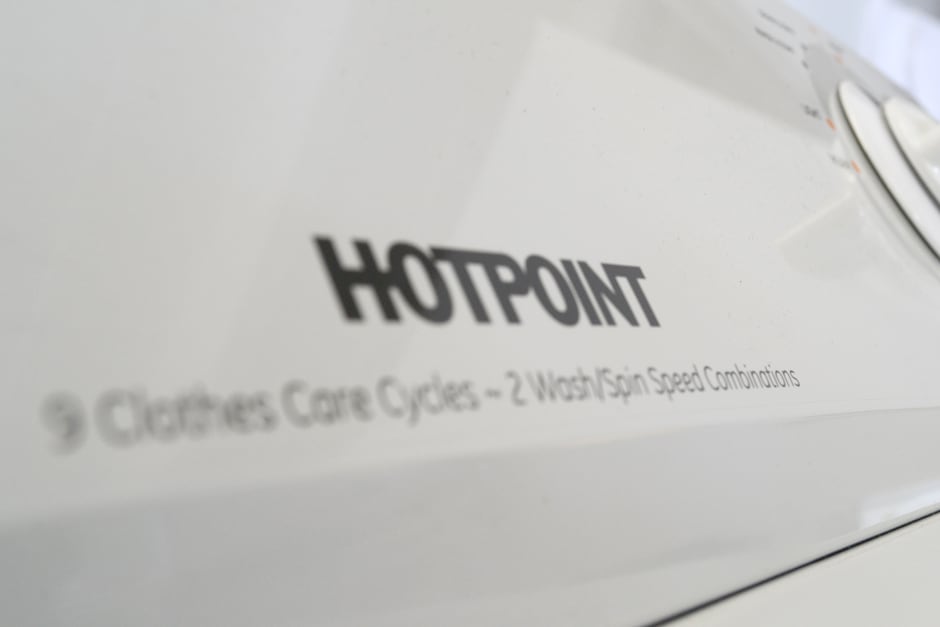Pros
Cons
Introduction
Golly, do I have a washing machine for you. The Hotpoint HSWP1000MWW (MSRP $469) is your mother's washing machine. Nothing on this machine would confound someone from the 70's. Its massive pole agitator will smack stains so hard that your clothes and your water bill will feel it.
Indeed, it's one of the least expensive washers on the market, and it's a traditionalist's delight. But if you plan on owning this machine for many years, you may end up paying more than you bargained for.
Design & Usability
Like a joke you heard before, this washer is serviceable, but stale.
The Hotpoint HSWP1000MWW will invoke a sense of deja vu. It's practically a stereotype of an American washing machine. There was a time that top-loaders outpaced their front-loading brethren in the capacity department. This Hotpoint is no Tiny Tim with 3.5 cubic foot capacity, but today there are plenty of top- and front-loaders with significantly more space.
A point in favor of ergonomics: The drum is raised up, so it's easy to get your laundry out. Using the HSWP1000MWW involves turning and pulling manual controls. There are no features, gimmicks, or things of note to get in the way of operating this washer. This Hotpoint is the reverse Sphinx.
{{photo_gallery "gallery" }}
Performance & Features
A heavy drinker and a hard fighter
Though this Hotpoint doesn't cost much to buy, it costs a lot to run. The most efficient machines we've tested cost around $30 a year in water and energy costs. This Hotpoint, on the other hand, runs around $73 per year. Over the course of five years, this machine will use its purchase price in water and energy alone.
The HSWP1000MWW might not be efficient, but it is somewhat effective. This washer whacked every stain we threw at it. The Casual cycle set to heavy turned out to be the toughest, and the usual suspects such as red wine and sweat were no match for this washing machine's mighty agitator.
Too bad that the HSWP1000MWW was equally rough on fabrics, pulling threads on our mechanical action test strips. Anything fragile that goes in there will wear prematurely. Conspiracy theorists would say it's a ploy by the clothing industry to get you to buy more sweaters.
Conclusion
Most things have an archetype. Ask someone to think of an apple, and they'll likely picture a red delicious. Ask someone to think of a washing machine, and they'll probably picture something that looks like the Hotpoint HSWP1000MWW. It is the barest of minimums.
If you have no need for modern technology, this washer might be for you. Just be aware that its inefficiency and power will cost you in the long run.
Science Time
The time has come...for science! Every washing machine that comes through our doors receives a battery of standardized tests. If you ever wondered how we test our machines, then you've come to the right place. With the HSWP1000MWW it's a matter of good news and bad news. The good news is that it uses time tested methods for stain removal. The bad news it saves no water for the fishes, or the ocean for that matter.
Cleaning Performance
A washing machine should be able to clean your laundry. To test cleaning performance, we use standardized stain strips that are coated with common household substances such as blood and sweat. These strips are placed in eight pound test loads. In a top loader like the HSWP1000MWW, the strips are placed in the same location relative to the pole agitator every time. After the strips come out, they are placed under a photospectrometer and beams of light determine how much of the stain is removed. It did very well against our sweat and cocoa stains. That shows range since these two substances lie on opposing sides on the pH scale.
Efficiency
Efficiency comes in two forms: what goes into a washer and what comes out. We measure what goes in by hooking a washer up to water and watt meters. That's how we learned that the HSWP1000MWW is a thirsty machine. We estimate that it'll probably cost you around $73 a year to run this washer—a very hefty sum.
What comes out of a washer are wet clothes. These clothes either dry by air or by dryer. Time and energy is ultimately what is needed. The drier the clothes come out of the washer the better. In this regard, this Hotpoint did alright, but not great. It averaged around 72% of test load's weight in water. The ideal number is around 50%.
Meet the tester
Jonathan Chan currently serves as the Lab Manager at Reviewed. If you clean with it, it's likely that Jon oversees its testing. Since joining the Reviewed in 2012, Jon has helped launch the company's efforts in reviewing laptops, vacuums, and outdoor gear. He thinks he's a pretty big deal. In the pursuit of data, he's plunged his hands into freezing cold water, consented to be literally dragged through the mud, and watched paint dry. Jon demands you have a nice day.
Checking our work.
Our team is here to help you buy the best stuff and love what you own. Our writers, editors, and experts obsess over the products we cover to make sure you're confident and satisfied. Have a different opinion about something we recommend? Email us and we'll compare notes.
Shoot us an email


